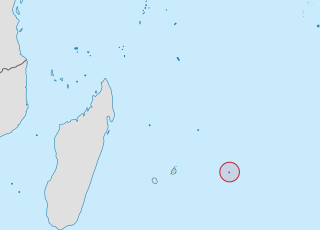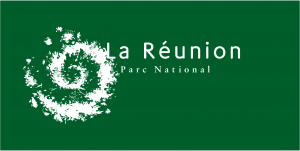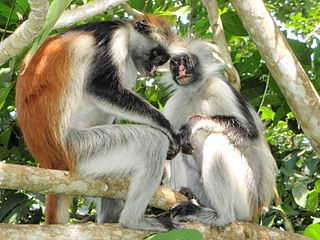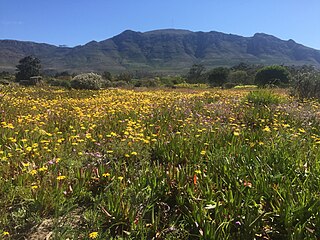This article needs additional citations for verification .(December 2023) |

Monvert Nature Park is a nature walk, arboretum, botanical gardens and rehabilitated indigenous forest, situated in Forest Side, Curepipe, Mauritius.
This article needs additional citations for verification .(December 2023) |

Monvert Nature Park is a nature walk, arboretum, botanical gardens and rehabilitated indigenous forest, situated in Forest Side, Curepipe, Mauritius.


The area of Monvert was named after Chevallier Antoine de Monvert, and was previously a dense indigenous forest (with "Bois de Natte", "Bois Manioc" and "Manglier vert" being the most commons tree species). The entire region was taken for logging in the early 1900s, but while much of the surrounding land was re-planted with fast-growing invasive trees such as eucalyptus from Australia, a portion was left, that naturally re-grew some indigenous Mauritian plants.
This area was set aside for conservation because of the unusually high biodiversity involving critically endangered species, and the nature park was set up between 2001 and 2006. As state land it is managed by the Mauritian National Forestry Service.
The nature park entrance is located just off the A10 road, in the region of Forest Side, about 3 kilometres south-east of the Curepipe Town Centre.

It is the most easily accessed of any indigenous Mauritian forest, being closest to any central urban area. Most of the other remnants of the island's native ecosystems are located either on off-shore islands, or high in Black River Gorges National Park. [1] [2]

The nature park has two main sections, the smaller visitors interpretation centre, and the nature walk over the larger natural area.
The Visitors Centre, just off the A10, contains a display of the biodiversity, forests and invasive species of the country, as a basic overview.
Behind the centre is the arboretum, where over 150 labelled endemic and indigenous species are grown on grassy slopes intersected with paths. Many are critically endangered or extinct in the wild.
At the bottom of the arboretum is the fernery, where many of the island's critically endangered endemic ferns and orchids are displayed. A raised kiosk also serves as a venue for activities. [3]
The main natural area is located several kilometres further down the road, past the visitors centre. Here, several looped trails go through kilometres of gradually recovering indigenous forest, and past a large elevated platform at the park's highest point, from which the surrounding region can be viewed. [4]

The Mascarene Islands or Mascarenes or Mascarenhas Archipelago is a group of islands in the Indian Ocean east of Madagascar consisting of islands belonging to the Republic of Mauritius as well as the French department of La Réunion. Their name derives from the Portuguese navigator Pedro Mascarenhas, who first visited them in April 1512. The islands share a common geological origin beneath the Mascarene Plateau known as the Mauritia microcontinent which was a Precambrian microcontinent situated between India and Madagascar until their separation about 70 million years ago. They form a distinct ecoregion with unique biodiversity and endemism of flora and fauna.

Rodrigues is a 108 km2 (42 sq mi) autonomous outer island of the Republic of Mauritius in the Indian Ocean, about 560 km (350 mi) east of Mauritius. It is part of the Mascarene Islands, which include Mauritius and Réunion. Like Agaléga, Rodrigues is a constituent island of the Republic of Mauritius, under the Constitution of Mauritius and still remains, as explicitly defined by the same Constitution, part of the Sovereignty of Mauritius, together with the following islands: "Agalega, Tromelin, Cargados Carajos, Chagos Archipelago ... Diego Garcia and other islands included in the State of Mauritius".

Conservation in New Zealand has a history associated with both Māori and Europeans. Both groups of people caused a loss of species and both altered their behaviour to a degree after realising their effect on indigenous flora and fauna.

Out of the total 1,092 km2 of land in Hong Kong, three-quarters is countryside, with various landscapes including beaches, woodlands, and mountain ranges being found within the small territory. Most of Hong Kong's parks have abundant natural diversity, usually containing over 1,000 species of plants.
The Mauritian Wildlife Foundation (MWF) is an independent, non-governmental, non-profit conservation agency working in Mauritius and the Outer Islands to save threatened endemic local flora and fauna.

Round Island is an uninhabited islet 22.5 kilometres north of Mauritius. It has an area of 1.69 square kilometres and a maximum elevation of 280 metres. The island has been a nature reserve since 1957 and is administered jointly by the National Parks and Conservation Service and the Mauritian Wildlife Foundation. The island has been designated an Important Bird Area (IBA) by BirdLife International.

The Mauritian flying fox, also known as Greater Mascarene flying fox or Mauritius fruit bat is a large megabat species endemic to Mauritius and La Réunion.
The wildlife of Mauritius consists of its flora and fauna. Mauritius is located in the Indian Ocean to the east of Madagascar. Due to its isolation, it has a relatively low diversity of wildlife; however, a high proportion of these are endemic species occurring nowhere else in the world. Many of these are now threatened with extinction because of human activities including habitat destruction and the introduction of non-native species. Some have already become extinct, most famously the dodo which disappeared in the 17th century.

Curepipe Botanic Gardens in Route des Jardins, Curepipe, is the second largest botanical garden in Mauritius.

Black River Gorges National Park is a national park in the hilly south-western part of Mauritius. It was proclaimed on June 15, 1994 and is managed by the National Parks and Conservation Service. It covers an area of 67.54 km2 including humid upland forest, drier lowland forest and marshy heathland. Facilities for visitors include two information centres, picnic areas and 60 kilometres of trails. There are four field stations in the park which are used for National Parks and Conservation Service and Mauritian Wildlife Foundation research and conservation projects.

Réunion National Park is a National Park of France located on the island of Réunion, an overseas department in the western Indian Ocean. Established on 5 March 2007, the park protects the endemic ecosystems of Les Hauts, Réunion's mountainous interior, and covers around 42% of the island. Notable endemic species include the Réunion cuckooshrike and the Reunion Island day gecko.

The wildlife of Zanzibar consists of terrestrial and marine flora and fauna in the archipelago of Zanzibar, an autonomous region of Tanzania. Its floral vegetation is categorized among the coastal forests of eastern Africa as the Southern Zanzibar-Inhambane coastal forest mosaic and the Northern Zanzibar-Inhambane coastal forest mosaic. Its faunal species are mostly small animals, birds, and butterflies.

The wildlife of Haiti is important to the country because of its biodiversity. According to the World Conservation Monitoring Centre, Haiti is considered to be "one of the most biologically significant countries of the West Indies". With an estimated 5,600 plant species on the island of Hispaniola, some of which only occur in Haiti, 36% are considered as endemic to the island. A mountainous area country, it is situated in the western three-eighths of Hispaniola and shares a border with the Dominican Republic. There are nine life zones, from low desert to high cloud forests, as well as four mountain ranges, and hundreds of rivers and streams and the coral reefs in the seas that surround the islands. Issues of environmental damage, expanding population, deforesting and erosion are of concern; less than 2% of the original forest remains on account of deforestation. This degradation is traced from the 17th century to 19th century starting with the French colonization of the Haiti and population explosion during the 20th century and for the purpose of forestry and sugar-related industries, degraded the forests. and the environment.

Ferney La Vallée is a forest and wildlife reserve situated in the Bambou mountains north of Mahébourg in Grand Port District, Mauritius. It is managed by the La Vallée de Ferney Conservation Trust.

Bras d'Eau National Park is one of only three national parks in Mauritius. It is located in the north-east of the island.

Diospyros tessellaria is a species of tree in the family Ebenaceae.

Diospyros revaughanii is a rare species of tree in the family Ebenaceae (ebony).

Perrier Nature Reserve is a small nature reserve protecting indigenous plants and primary forest, in the central highlands of Mauritius. It is still closed to the public.

Ile aux Aigrettes is an islet off the south-east coast of Mauritius. It functions as a nature reserve and a scientific research station. It is also a popular visitors attraction — both for tourists and for Mauritians.

Tokai Park, previously known as "Tokai Forest", is a small wing, about 600 ha, of the greater Table Mountain National Park in Cape Town, South Africa. Tokai Park is made up of two sections: upper and lower Tokai Park. Lower Tokai Park is flat, and characterized by the threatened Cape Flats Sand Fynbos. Upper Tokai Park is on the slopes of Constantiaberg Mountain, and consists of conservation area as well as the Tokai Arboretum. Upper Tokai Park is characterized by Peninsula Granite Fynbos, Peninsula Sandstone Fynbos and Afromontane Forest and noted for its diversity.